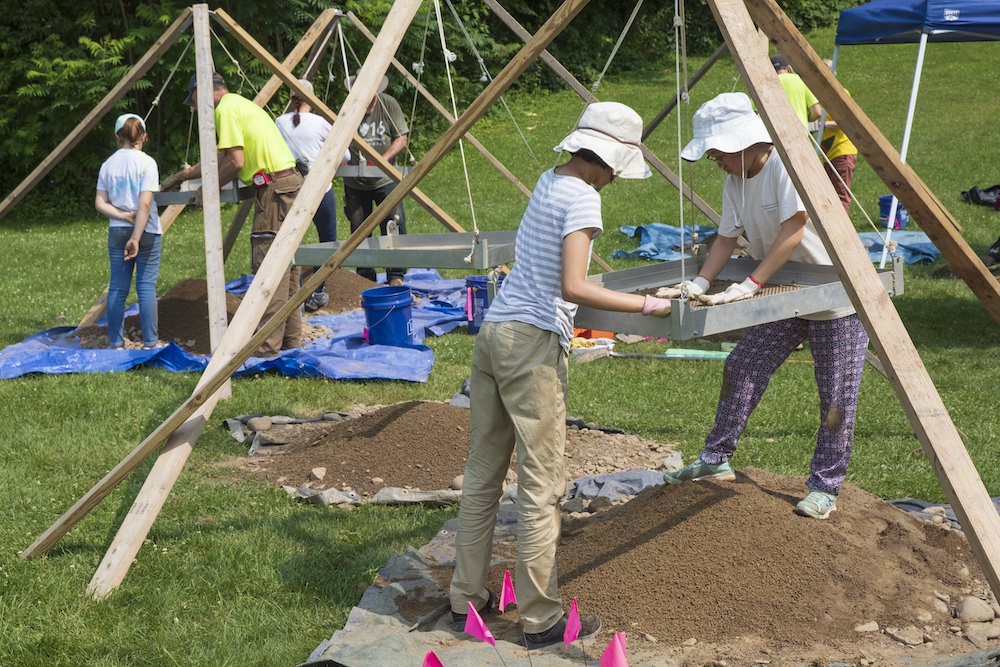Binghamton University to launch archaeology program for local middle schoolers
National Science Foundation grant awarded to boost interest in STEM concepts

Archaeology. Exploring the past through ancient artifacts. It’s not something a lot of middle-schoolers get the opportunity to experience firsthand, but that’s about to change for students at two Broome County schools thanks to a new grant awarded to the Public Archaeology Facility at Binghamton University.
The National Science Foundation has awarded a two-year, $295,951 grant through its Advancing Informal STEM Learning (AISL) Pilot & Feasibility Program to help a team of educators at the Public Archaeology Facility implement an afterschool archaeology program for students in Whitney Point and Windsor schools. The program will serve approximately 150 students in grades 6-8 over the two-year pilot project.
Students tend to start losing interest in STEM concepts during middle school, said Laurie Miroff, director of the Public Archaeology Facility. She and her team hope that this program will stimulate them to become STEM learners.
“Archaeology is inherently interesting and exciting, and so we’re hoping that will stimulate students to be engaged with STEM concepts and hopefully create long-term, lasting impacts, so that they’ll be lifetime STEM learners,” said Miroff.
Students in the program will study data on artifacts (e.g., arrowheads, darts, spear points) to create hypotheses about how people in the past made stone tools, acquired and prepared food, and lived on the landscape. They will also engage with indigenous leaders, who will present their worldview, their science and their view of their past to students. Finally, the students will create posters that they will present at Binghamton University to citizen scientists, parents, indigenous leaders and the community.
“The data that we’re acquiring from the citizen scientists is all new,” said Miroff. “The students will be working on real research questions with real data and providing new scientific research that will then be put out to the local community and academic communities. We have indigenous knowledge, we have youth learners, we have citizen scientists. Bringing all of those different people together to work on a project and talk to one another is an incredibly exciting opportunity.”
Miroff said she would have loved to participate in a program like this when she was in middle school, but no such opportunities existed at that time.
“I have wanted to be an archaeologist since about sixth or seventh grade — I’ve always known I wanted to do it,” she said. “Of course, we didn’t have the internet, but I read everything I could about how to become an archaeologist. There was nothing like this available. There were no opportunities available to learn about archaeology firsthand.”
Nina Versaggi, PAF senior research associate, and Lynda Carroll, PAF community outreach associate, are also on board. The team also includes Amber Simpson from the Department of Teaching, Learning and Educational Leadership (TLEL); and Luann Kida, director of Binghamton University Community Schools (BUCS), the first county-wide, university-assisted community schools model in the nation, which works to extend learning opportunities to area schools.
Kida said the archaeology program highlights the power and innovation that can occur through the community school collaborative approach.
“This program will bring science curriculum and connections to higher education to both districts, providing opportunities many of their students may not have without this programming,” said Kida.
The team will soon meet with school administrators to discuss the specifics of the grant and the after-school program. The initial plan was to start going into the schools in winter 2021, but the program might be delayed due to the COVID-19 pandemic. If the organizers can’t get into schools by February or March, the NSF has granted a one-year extension.
Whenever the program begins, both middle schoolers and college students will benefit, said Kida. Binghamton University students will gain experience and exposure that can’t be found in the classroom, while the students at Whitney Point and Windsor will make connections with college students from outside of their hometown.
“I have witnessed the power that these connections can have for all those involved when we made a similar connection with the Physics Department,” said Kida. “The graduate students strengthened their understanding of concepts as they were charged with breaking material down in a way that middle school children could learn and apply. The middle school students were in awe of Binghamton University and the physics lab, generating all kinds of questions about college and various majors they might pursue. Everyone walks away feeling energized and college students feel like they are making a difference!”
